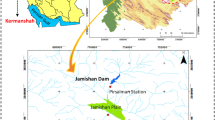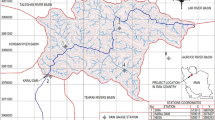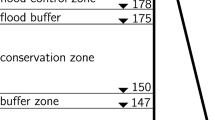Abstract
The aim of this study is to determine whether dam reoperation (the adjustment of reservoir operating rules) is an effective adaptation strategy to reduce the potential impacts of climate change and regional socio-economic developments. The Xinanjiang-Fuchunjiang reservoir cascade, located in Hangzhou Region (China), is selected as case study. We use a scenario-based approach to explore the effects of various likely degrees of water stress for the future period between 2011 and 2040, which are compared to the control period from 1971 to 2000. The scenario impacts are simulated with the WEAP water allocation model, which is interlinked with the NSGA-II metaheuristic algorithm in order to derive optimal operating rules adapted to each scenario. Reservoir performance is measured with the Shortage Index (SI) and Mean Annual Energy Production (MAEP). For the investigated scenarios, adapted operating rules on average reduce the SI with 84 % and increase the MAEP with 6.4 % (compared to the projected future performance of conventional operation). Based on the optimization results, we conclude that for the studied case dam reoperation is an effective adaptation strategy to reduce the impact of changing patterns of water supply and demand, even though it is insufficient to completely restore system performance to that of the control period.







Similar content being viewed by others
References
Allen RG, Pereira LS, Raes D, Smith M (1998) Crop evapotranspiration—guidelines for computing crop water requirements—FAO irrigation and drainage paper 56. FAO, Rome
Chang F, Chen L, Chang L (2005) Optimizing the reservoir operating rule curves by genetic algorithms. Hydrol Process 19:2277–2289
Chang L, Chang F (2009) Multi-objective evolutionary algorithm for operating parallel reservoir system. J Hydrol 377:12–30
Chen L, McPhee J, Yeh WWG (2007) A diversified multiobjective GA for optimizing reservoir rule curves. Adv Water Resour 30:1082–1093
Chou FNF, Lee HC, Yeh WWG (2013) Effectiveness and efficiency of scheduling regional water resources projects. Water Resour Manag 27:665–693
CNKI (2013) China economic and social statistics database. http://www.cnki.net/. Accessed 15 Feb 2013
Deb K, Pratap A, Agarwal S, Meyarivan T (2002) A fast and elitist multiobjective genetic algorithm: NSGA-II. IEEE Trans Evol Comput 6:182–197
Deltares (2013) Ribasim. http://www.deltares.nl/en/software/101928/ribasim. Accessed 8 April 2013
Fu X, Li A, Wang L, Ji C (2011) Short-term scheduling of cascade reservoirs using an immune algorithm-based particle swarm optimization. Comput Math Appl 62:2463–2471
Gordon C, Cooper C, Senior A, Banks H, Gregory JM, Johns TC, Mitchell JFB, Wood RA (2000) The simulation of SST, sea ice extents and ocean heat transports in a version of the Hadley Centre coupled model without flux adjustments. Clim Dyn 16:147–168
Gosschalk EM (2002) Reservoir engineering: guidelines for practice. Thomas Telford, London
Hangzhou Bureau of Forestry & Water Conservancy (2006, 2007, 2008) Hangzhou water resources bulletin [in Chinese]. Hangzhou Bureau of Forestry and Water Conservancy, Hangzhou
Hurkmans R, Terink W, Uijlenhoet R, Torfs P (2010) Changes in streamflow dynamics in the rhine basin under three high-resolution regional climate scenarios. J Clim 23:679–699
Ines AVM, Hansen JW (2006) Bias correction of daily GCM rainfall for crop simulation studies. Agric For Meteorol 138:44–53
IPCC (2007) Contribution of working group II to the fourth assessment report of the intergovernmental panel on climate change. Cambridge University Press, Cambridge
Karamouz M, Houck MH, Delleur JW (1992) Optimization and simulation of multiple reservoir systems. J Water Resour Plan Manag ASCE 118:71–78
Kumar DN, Naresh R (2007) Efficient real coded genetic algorithm to solve the non-convex hydrothermal scheduling problem. Electr Power Energy Syst 29:738–747
Kumar DN, Reddy MJ (2007) Multipurpose reservoir operation using particle swarm optimization. J Water Resour Plan Manag ASCE 133:192–201
Labadie JW (2004) Optimal operation of multireservoir systems: state-of-the-art review. J Water Resour Plan Manag ASCE 130:93–112
Leander R, Buishand TA (2007) Resampling of regional climate model output for the simulation of extreme river flows. J Hydrol 332:487–496
Li X, Wei X (2008) An improved genetic algorithm-simulated annealing hybrid algorithm for the optimization of multiple reservoirs. Water Resour Manag 22:1031–1049
Liu P, Guo S, Xu X, Chen J (2011) Derivation of aggregation-based joint operating rule curves for cascade hydropower reservoirs. Water Resour Manag 25:3177–3200
Minville M, Brisette F, Krau S, Leconte R (2009) Adaptation to climate change in the management of a canadian water-resources system exploited for hydropower. Water Resour Manag 23:2965–2986
Minville M, Brisette F, Leconte R (2010) Impacts and uncertainty of climate change on water resource management of the Peribonka river system (Canada). J Water Resour Plan Manag ASCE 136:376–385
Oliveira R, Loucks DP (1997) Operating rules for multireservoir systems. Water Resour Res 33:839–852
Ostadrahimi L, Marino MA, Afshar A (2012) Multi-reservoir operation rules: multi-swarm PSO-based optimization approach. Water Resour Manag 26:407–427
Payne JT, Wood AW, Hamlet AF, Palmer RN, Lettenmaier DP (2004) Mitigating the effects of climate change on the water resources of the Columbia river basin. Clim Change 62:233–256
Perrin C, Michel C, Andréassian V (2003) Improvement of a parsimonious model for streamflow simulation. J Hydrol 279:275–289
Raje D, Mujumdar PP (2010) Reservoir performance under uncertainty in hydrologic impacts of climate change. Adv Water Resour 33:312–326
Rani D, Moreira MM (2010) Simulation-optimization modeling: a survey and potential application in reservoir systems operation. Water Resour Manag 24:1107–1138
Schumann AH (1995) Flexibility and adjustability of reservoir operation as an aid for sustainable water management. In: Modelling and management of sustainable basin-scale water resource systems, pp 291–297
SEI (2013) WEAP: water evaluation and planning system. http://www.sei-international.org/weap-the-water-evaluation-and-planning-system . Accessed 26 April 2013
The World Bank (2013) GDP deflator. http://data.worldbank.org. Accessed 16 Jan 2013
Tung C, Hsu S, Liu CM, Li S (2003) Application of the genetic algorithm for optimizing operation rules of the LiYuTan reservoir in Taiwan. J Am Water Resour Assoc 39:649–657
US Army Corps of Engineers (1997) Hydrologic engineering requirements for reservoirs. http://publications.usace.army.mil. Accessed 5 May 2012
US Army Corps of Engineers (2013) HEC-ResSim. http://www.hec.usace.army.mil/software/hec-ressim/. Accessed 8 April 2013
Vörösmarty CJ, Green P, Salisbury J, Lammers RB (2000) Global water resources: vulnerability from climate change and population growth. Science 289:284–288
Wada Y, Van Beek LPH, Viviroli D, Dürr HH, Weingartner R, Bierkens MFP (2011) Global monthly water stress: 2. Water demand and severity of water stress. Water Resour Res 47:WO7518. doi:10.1029/2010WR009792
Wang Q, Zhang S, Ho E (2010) The China files: Chinese economy through 2020. http://www.morganstanley.com. Accessed 15 Jan 2013
Wang X, Fan G, Liu P (2007) Pattern and sustainability of China’s economic growth towards 2020. http://draft.cerdi.org/. Accessed 15 Jan 2013
Xu YP, Zhang X, Tian Y (2012) Impact of climate change on 24-h design rainfall depth estimation in Qiantang River Basin, East China. Hydrol Process 26:4067–4077
Yin X, Yang Z, Yang W, Zhao Y, Chen H (2010) Optimized reservoir operation to balance human and riverine ecosystem needs: model development, and a case study for the Tanghe reservoir, Tang river basin, China. Hydrol Process 24:461–471
Acknowledgments
This project was partially supported by the International Science and Technology Cooperation Program of China (Grant No. 2010DFA24320). The authors would like to thank Ma Chong for data collection, Zhu Qian for rainfall-runoff modelling and the operators of Xinanjiang Reservoir and Fuchunjiang Reservoir for their data provision.
Author information
Authors and Affiliations
Corresponding authors
Rights and permissions
About this article
Cite this article
Vonk, E., Xu, Y.P., Booij, M.J. et al. Adapting Multireservoir Operation to Shifting Patterns of Water Supply and Demand. Water Resour Manage 28, 625–643 (2014). https://doi.org/10.1007/s11269-013-0499-5
Received:
Accepted:
Published:
Issue Date:
DOI: https://doi.org/10.1007/s11269-013-0499-5




